Fun foliage that you can eat (mostly)
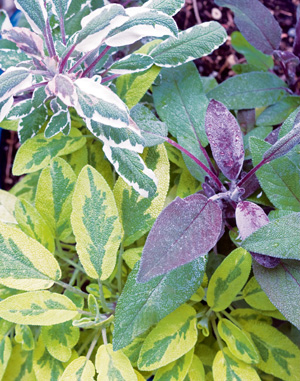
Explore the herb section of your nursery for new container design candidates. Photo credit; Gary Hayes
At this time of year it isn’t unusual for me to be designing 60 or more container gardens a week. Each client has their own preferences in terms of color and style but all expect a ‘wow’ factor. And I expect to deliver!
My biggest challenge is always to find fabulous foliage which works with and enhances the overall design. Focusing on flowers is guaranteed to bring disappointing results at some point during the season as many plants go through waves of blooming with ‘blah’ periods in between. Yet adding just a few special foliage plants changes all that. I routinely scour the smaller sizes of variegated shrubs as well as colorful indoor foliage plants to expand my plant palette. However, I still felt my latest project looked a little ‘flat’ until I wandered into the herb section of the nursery where I struck gold! Here are a few that caught my eye (and nose).
SAGE (Salvia)
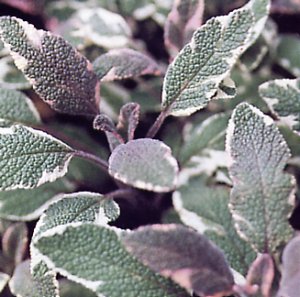
Tricolor sage offers fabulous shades of green-grey, white, pink and purple. Photo credit; gardening.eu
Tricolor sage (Salvia officinalis 'Tricolor'); fabulous for using with pink, white or burgundy themes this colorful sage adds sparkle and depth to any sunny combination. This is a good ‘filler’ for containers, as it can reach 12-15” in height
Purple sage (Salvia officinalis purpurea); the smoky tones of the large, fuzzy oval leaves work well with silver sedums such as ‘Cape Blanco’ stonecrop (Sedum spathulifolium 'Cape Blanco'). This combination would thrive in a hot sunny site with well-drained soil and has the added benefit of being deer resistant.
THYME (Thymus)
Silver posie thyme (Thymus vulgaris ‘Silver posie’); this evergreen herb adds a delicate look with its small green leaves edged in white. Use it to edge garden borders (it would be wonderful with pink roses), or in containers.
Lemon thyme (Thymus × citriodorus); a favorite for year round plantings this yellow and green variegated form adds a bright note and citrus scent. For great color contrast and a contemporary twist team it with black mondo grass (Ophiopogon planiscapus 'Nigrescens’)
OREGANO & MARJORAM (Origanum)
Golden oregano (Origanum vulgare 'Aureum’ ); this perennial dies down in winter but comes back each year to produce a 12” mound of golden leaves. Use this to edge raised borders or containers but trim back after flowering to keep it tidy. Looks great in a cobalt blue pot.
Variegated marjoram (Origanum vulgare 'Variegata'); pretty green and white variegated leaves always look fresh. A great ‘spiller’
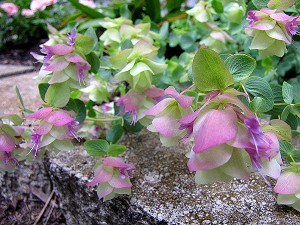
'Kent beauty' oregano may not be edible but with looks like this who cares? Photo courtesy Kylee Baumle of www.ourlittleacre.com
‘Kent beauty’ oregano (Origanum rotundifolium cv.)– this is an ornamental (non-edible) variety but don’t let that put you off as it is an outstanding little plant. Heart shaped leaves in blue-green are a welcome change from the typical mid-green, mid-sized foliage of summer annuals. Yet this herb offers even more with tiers of charming pink and chartreuse bracts (often incorrectly referred to as flowers). Color is best in full sun but will also do well in part shade.
MINT (Mentha)
Pineapple mint (Mentha suaveolens 'Variegata'); I love the bold green and white variegated leaves, slightly ruffled at the edges and coarse to the touch, which I initially thought was a Plectranthus. When the leaves are crushed a light pineapple fragrance is released. This looks fabulous mingling in a sunny container where it can throw out stems to brighten up the more traditional offerings such as geraniums and African daisies. Roll up the leaves and slice thinly (as you would with basil) to add to fruit salads. Scrumptious!
Pineapple mint will spread indefinitely just like the common garden mint so keep it in a container to curb its enthusiasm.
If you would like to use some of these herbs for cooking as well as their ornamental value you may want to find an organic selection. Whether you eat them or not, these colorful plants will add fragrance and a new zip to your containers this summer for their foliage alone.
Email me photos of your favorite combinations!
A special thank you to my friend Tanya who introduced me to pineapple mint and inspired this post
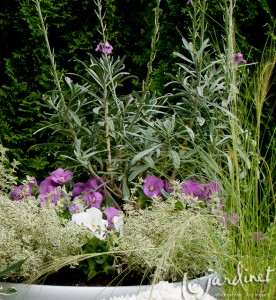
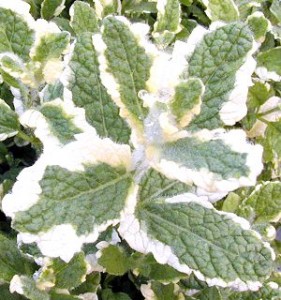
I am always looking for new, tasty varieties of herbs. And I like your ideas on how to design with them. I like letting some of the herb plants flower since they are especially attractive to bees.
Good point about the bees Mary – I've found they love thyme especially.
Hi Karen, What a great idea! I have been using perennial groundcovers in my container plantings for a few years, but it never occurred to me to use herbs. On the weekend, I saw lovely pots of thyme. Now, I am thinking of going back and buying a few pots of it to add to some of my lacklustre containers. (I find many perennial groundcovers over-winter nicely in pots. In spring, I don't have to start my containers from scratch. I am wondering if herbs like thyme will be just as hardy in containers.)
Jennifer, we are in zone 6b-8a and I have many herbs which do well year round in containers. Thyme is really tough but we also use sage and rosemary for winter color and texture. Experiment!
What great ideas, Karen! A lot of variegated plants scorch in the sun here, but I'd love to give the purple sage a try. I have a habit of killing ornamental oreganos in pots and have no idea what I'm doing wrong, but the bracts are so beautiful that they tempt me every year anyway.
How interesting that variegated plants scorch in NM. Even tougher foliage such as thyme?
Thyme has such small leaves that the golden types would probably be OK, Karen. I have a variegated ivy on a shady north wall that does pretty well, though it still gets "burned" by wind every winter.
[…] sparkle to the foliage line up and a sneaky ‘Kent beauty’ oregano, featured recently in my blog brings the softest shades of pink and green plus a light herbal fragrance. This one looks pretty […]